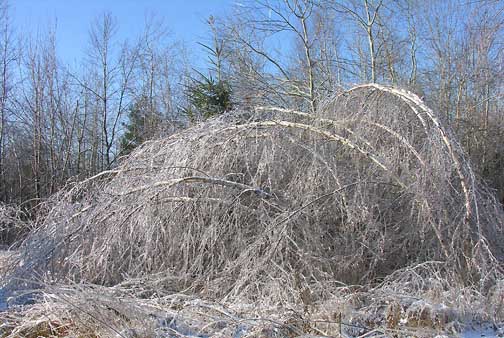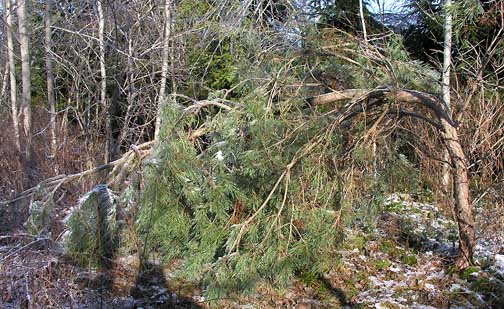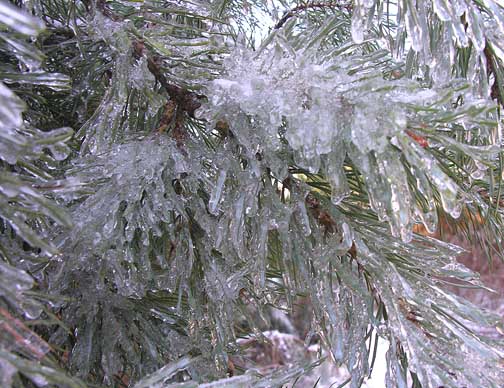December 6th, 2006
a terrible beauty
Yesterday afternoon, I spent a couple of hours clearing broken trees and branches off of the main trail loop in the woods at the front of the farm. I haven’t even ventured into the woods at the back as I’m sure it will be utter chaos there. Perhaps trail clean-up will be a project that Don and I can work on over Christmas. Although the loss of so many trees is unfortunate and has created a terrible mess, I must admit that the ice-covered branches are quite beautiful when illuminated by the sun.
Regarding the damage, the worst hit were the poplars, that broke off like so many toothpicks and lay flattened on the ground. The most noticeable were the birch, which are weighted down by the ice that clings to their many small twiglets and catkins. If the ice melts away soon enough, some of the trees may recover and straighten up. However, the longer they stay down, the less likely that will be — especially if we get a snowfall to add weight to the already stessed trees. The group in the above photo are about 20 to 25 foot tall trees. I don’t have much hope for them as they have very heavily iced branches and the weather forecast is for sticky snow later this afternoon, followed by colder temperatures for the next few days.
Also greatly damaged are the Scots pines (Pinus sylvestris), a non-native species that are actually considered pests in our region. We have several large groves of these that grew up from seed that blew onto the property from neighbouring groves. I noticed that they stood up very poorly to the ice, unlike our native pine and spruce which seem to have weathered the storm quite well. The Scots pines seem very brittle and larger branches, and often the top third or more of larger trees, break off as they become coated with ice. Smaller trees bend over and the trunk shatters as in the above example. As you can see in the photo below, the long, thick needles of the Scots pine become heavily iced into a thick mass. They branches weigh an incredible amount once iced. That small tree in the above photo — it was probably about 10 to 12 feet tall before being bent over — was so heavy that I could barely drag it off the trail after sawing through the cracked wood of the trunk. One of the Scots pine groves is a tangled mess of broken trees frozen into one great lump. The White-tailed deer like to hang out in there — the needles of the pines being so long and sharp as to be impenetrable to humans. I will leave the deer to their icy fortress.
Tags: ice storm, Scots Pine, Pinus sylvestris



December 6th, 2006 at 3:04 pm
Wow. I don’t think I can think of anything more radically selective during the winter than an ice storm. When they happen on a regular interval they can be excellent pruning devices, ridding trees of deadwood, but when they happen irregularly and appear after many years without one, they can be devastating.
I’m really sorry about your poplars. From the pics of some of the other trees it looks like bending was a consequence. Hopefully they can bounce back from that.
It’s odd that we used to get regular ice storms, which worked well, but that in the last 15 years have had only one or two mild ones. Formerly the ice storms served a convenient function but it’s been so long now that should we get another it will be a problem.
I have to admit that I egg on the increasingly thicker and thicker droplets of water, the ones that hang heavier and heavier on the twigs and branches, in the hopes of a freeze. Here in the south we’re thirsty for drama. We may regret it in the morning but our winters are normally so boring.
December 6th, 2006 at 3:27 pm
Wayne – The damage that a heavy ice buildup can cause never ceases to amaze me. A couple of the things that I’ve noticed after watching trees break up after an ice storm is that they often seem okay if we just get some ice and a thaw, but if we get heavy snow, and/or especially if the temperature drops quickly, the trees really start to break apart. I’m sure there’s a good explanation for why this would be so. As mentioned in my earlier post on the ice storm, when we get those particular conditions, the trees make horrible cracking sounds like gunshots. I think the wood practically explodes as it becomes brittle as the temperatures fall. That does seem to make sense to me as wood behaves quite differently in very cold weather. For example, in deep winter, it’s quite easy to break off branches with your bare hands — ones that you couldn’t break in summer as the wood would be too flexible. Perhaps that’s why ice storms seem to do such incredible damage when they occur up here where they aren’t really that common (or at least, didn’t seem to be until recently). Btw, now that we’re doing this tree measuring thng, there are 2 forest that lies south of here about 60 miles that we’ll visit sometime this winter. Both have some fairly large, old trees. Awhile back, I noticed that a number of the oldest trees in both forests have badly deformed crowns – often having two tops instead of one, but you can tell that this happened ages ago. I’m guessing that they were damaged during an ice storm a long while ago.. perhaps 150 years ago. If I can measure some of the damaged ones and also the somewhat smaller trees that surround them, it might be possible to calculate a possible date for the storm.
Your description of being “thirsty for drama” made me laugh. Up here, we often get plenty of drama during our winter! It can be fun for a little while, but such things as blinding snowstorms, high winds and badly drifting snow, ice storms, and the major power outages aren’t a heck of a lot of fun after the first few hours! (-:
December 6th, 2006 at 4:13 pm
The snow we had last week was very wet and heavy, so it definitely brought down some weaker trees in the region. We have two large bushes out on the northside of our house that are splayed out on the ground. I’m hoping they’ll recover and stand upright again. The windstorm of the previous week actually had done most of the thinning, though. It was a double hit through the forests. There is something about ice on trees and leaves though that is quite picturesque. If it would just melt away quickly it would be perfect.
December 7th, 2006 at 3:31 am
I know that it’s not practical in a forest, but do you think that regular pruning of thin branches will help to prevent so much damage? Jusr wonder what people do to protect their ornamental trees and shrubs.
December 7th, 2006 at 4:02 am
Laura – I’m not sure if there would be a way to prevent this kind of ice damage. Certainly, the more branches a tree has (especially branches with many small twigs like the birch), the more ice it will accumulate, and the greater the weight of the canopy. I suppose reducing the number of branches might help to keep the upper part of the tree light. I guess the only drawback might be that the tree might loose some of the remaining branches and you would be left with a very scraggly tree with few branches and leaves. With larger trees, I doubt there’s a way to prevent damage. During the ice storm of ’98, I heard an interview with an arboriculturist who said that very large trees were carrying huge weights.. sometimes a couple or more thousand pounds of ice in their upper branches, so it wasn’t surprising that whole sections of trees were breaking away and crashing to the ground. At the back of our land, there are a bunch of huge Manitoba Maples. The canopies got so loaded with ice that the trees tore loose from the soil and tipped over on their sides. Very bizarre. There are many trees like that in forests up here now, and I suspect a good number of them fell over during the ’98 storm.
December 7th, 2006 at 2:27 pm
Those pictures remind me of the great ice storm of around 1959 in north Georgia. I was in grammar school at the time, so it must have been around just before 1960. It seems like the entire world was covered with ice. We listened to those gunshot sounds all night as our pines snapped. Our trees never did quite recover from that storm. But, as Wayne said, it seems that we don’t get those bad ice storms as often any more.